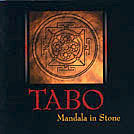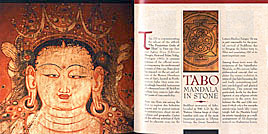TABO - MANDALA IN STONE

TABO
MANDALA IN STONE
PETER VAN HAM & TILMANN HÖHN
Produced by Tilmann Höhn, co-produced by Peter van Ham
Executive Producer: Hans Fischer
Composed and performed by Tilmann Höhn
Recorded and mixed at Electric HOMEland Studios, Wiesbaden,
September / October 1996 by Tilmann Höhn and Peter van Ham
All music published by HOMEfamily Musikverlag
Mastering by Peter Wenke
Liner notes by Peter van Ham
Photos by Peter van Ham and Aglaja Stirn
Cover and Inner sleeve designed by Holger Lindner and Peter van Ham
A Sonnenengel Musik Production in association with HOMEfamily
EURO 20.00, USD 20.00
1) TOWARDS CLEARER ABODES
2) THE WAYS OF THE MANDALA
3) BEYOND THE SNOWY PASSES
4) DIVINE PRESENCE
5) THE LEGEND OF SUDHANA
6) SIDDHARTA - A LIFE IN THE LIGHT
7) NO PLACE FOR MAN...
8) THE GREAT LOTSAVA
9) THE INNER SANCTUARY
10) FOR ALL SENTIENT BEINGS
11) BONUS TRACK (available on CD only): MO´ TSAMPA!

MANDALA IN STONE
This CD commemorates the release of the book "The Forgotten Gods of Tibet“ by Peter van Ham and Aglaja Stirn (Editions Menges, Paris and Belser Verlag, Stuttgart 1997). It contains remixes of the official music accompanying the multivisional lectures by Peter van Ham about his research on the art and culture of the Western Himalayan area of Spiti, located in Northwestern India. Here testimonies of a thousand year old Buddhist culture have come to light after 40 years of inaccessibility. Peter van Ham was among the first to explore this forbidden region and to present intense documentations about its art, culture and geography in books and articles.
Center of the cultural activities of Spiti and its adjacent areas was the Buddhist monastery of Tabo, founded in 996 A.D. by the Western Tibetan kings of Guge together with one of the most important persons in Tibetan history, the Great Translator Lotsava Rinchen Zangpo. He was in part responsible for the survival of Buddhism due to bringing the Sanskrit texts from India to Tibet and translating 160 of its most important ones. Among these texts were the scriptures of the Vajradhatu-Mandala, an 8th century Indian philosophical concept that explains the cosmic evolution in terms of clear light becoming dimand finally materializing itself into psychological and physical conditions. This concept was particularly fertile for the development of any artistic expression in the entire Asia between the 8th and 13th century, of which only a few examples remain today. Inside Tabo´s main temple hall it found its artistic translation in three-dimensional form as a wall arrangement of 33 clay sculptures of rare Kashmiri beauty.
1) TOWARDS CLEARER ABODES
In the lecture this piece describes the cosmic evolution emanating from the One and Absolute - symbolized by the Cosmic Buddha Vairochana, the „Omnipresent, Refulgent One“ - from a clear light into different aspects and colors of this light, finally becoming dim and materializing itself into forms of psyche and materia. The remix of the music expresses the strive of man from his hectic, urban situation towards a more peaceful and calmer terrain where he may be able to concentrate on the essential. This place is symbolized by the monastery of Tabo, where the seeker is confronted with the unique concept of Vajradhatu-Mandala. Through it he may catch a glimpse of the cosmic connections and realize his limited ability of perceiving the divine due to his short-minded consciousness, which is restricted by his passions and his attachment to illusion. Musically this dim form of existence is expressed in the change of atmosphere towards the end of the piece.
2) THE WAYS OF THE MANDALA
This music describes the development and diffusion of the Vajradhatu-Mandala from India across the whole Asian continent. Its light and high-pitched textures stand in contrast to the dark murmur of the Tibetan monks´ tantric recitals and symbolize the celestial goal to be attained by following the directions of the ritual.
3) BEYOND THE SNOWY PASSES
This piece describes a walk across the 3500 meters high plateau where the monastic complex of Tabo is situated above the Spiti river. Huge boulders with age-old rock inscriptions and a row of 216 chorten, the mystic monuments of Tibetan Buddhism, lead the visitor to the divine ground where finally the 1000-year old place of meditation and search for truth comes into sight: Tabo.
4) DIVINE PRESENCE
The visitor enters the most sacred temple of Tabo, the Tsug Lhakang, the „Chapel of the Enlightened Gods“. The aura of 1000 years of peaceful meditation till this very day creates a divine vibration inside the temple hall. This impression is deepened by the marvelous statues of Buddhas, Boddhisattvas and Goddesses attached to the walls, all colored in tinted variations of maroon, indigo and white, as well as the countless overwhelmingly fine paintings covering the entire space. The music reflects a walkabout in the Tsug Lhakang starting with an overall view and continuing with the meditation on the Mandala´s fierceful guardian deites, the Boddhisattvas of the different realms and finally the center of the Mandala, the fourfold being of Saravid Vairochana.
5) THE LEGEND OF SUDHANA
Sudhana was a mystic Indian prince that according to the legend gained wisdom in 52 different phases and situations of his life and finally was enlightened. His story is painted beneath the statues of Tabo´s Tsug Lhakang in one continuous narrative frieze. It was conceived as ideal and motivation for the Buddhist monks spending their life in the strive for perfection for the well-being of everything existing.
6) SIDDHARTA - A LIFE IN THE LIGHT
Opposite the paintings describing the legend of Sudhana one finds a continuous frieze with scenes of the life of the historic Buddha Shakyamuni from birth till death. Opulently adorned these paintings are rare images of late Indian style of painting that incorporated a multitude of influences ranging from the Central-Asian Silk-road over Persia as far as Greece.
7) NO PLACE FOR MAN...
Spiti, the district which houses the Tabo monastery is a hostile and barren high altitude mountain desert, surrounded by 6000 meters high peaks. Its valley grounds, situated between 3500 and 4300 meters height above sealevel are haunted by devastating sandstorms during summer and temperatures reaching -40 degrees Celsius for eight months in winter. Only app. 9500 people of Tibetan stock may possibly survive in this lonely moonscape of incomparable grandeur. Kipling, the famous British romancier was right in stating: „Surely the Gods live here...This is no place for man.!“ The music describes a flight above the vast and empty landscapes of the region and finally focusses on the cultural monuments such as the monasteries of Kye, Lhalung and Dhankar, that occasionally dot the cliffs and plateaus of Spiti.
8) THE GREAT LOTSAVA
The monastic complex of Tabo was founded by the Great Lotsava Rinchen Zangpo in 996 AD A most dedicated scholar that he was, he spent 19 years of his life studying the tantric forms of Buddhism in the sacred universities of India and translated 160 fundamental texts into Tibetan which were later on incorporated into the canonical scriptures of Tibet. He is said to have founded 108 places of worship in the Western Tibet and Transhimalaya, of which only few - and none such as Tabo - remain today. The glory of his achievements is reflected in the bright timbre of the composition.
9) THE INNER SANCTUARY
A final peek into the apse of the Tsug Lhakang where the most beautiful depictions of Buddhas and Boddhisattvas of all Tabo may be found. Two rows of 33 life-size paintings, executed in excellent Kashmirian style cover the walls enclosing a cella where a fivefold arrangement of stuccos belonging to the Cosmic Buddha Amitabha is positioned as Tabo´s inner sanctuary. The music is conceived as a reflection of the elegant posture in which the Boddhisattvas are depicted in the apse, graciously aiming for the heavenly abodes they belong to.
10) FOR ALL SENTIENT BEINGS
Tabo once served as an important place for the preservation and revival of Tibetan Buddhist culture. In the present serious situation that the people of Tibet are in - pursued, tortured and forced into exile by their Chinese occupants, it is to be hoped that Tabo may redevelop again to its original state of importance and help in keeping the culture of Tibet alive. 50 newly ordained monks as well as the reincarnation of one of the Dalai Lama´s most important teachers should be regarded as an auspicious beginning. May all sentient beings be happy. Sarva Mangalam...
- 11) MO´ TSAMPA
A little something extra for lovers of Tibetan cuisine...